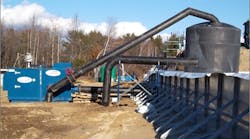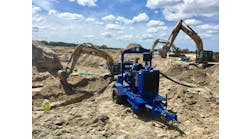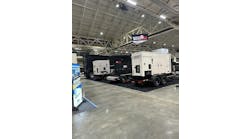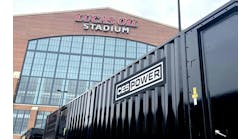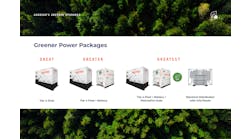RER: What is new in your company's line of pumps and what is unique about it?
Thompson: Like most equipment manufacturers, Thompson Pump is investing an enormous amount of time, money and assets to reconfigure our products to accept the Interim Tier 4 and Final Tier 4 diesel engines. In addition, since the cost to produce these units is significantly more expensive than current models, we are also offering portable pumps driven by alternative fuel engines — LP gas, natural gas, gasoline, hybrids, biodiesel and electric motors with variable frequency drives.
Grant: Tsurumi Pump is the largest electric submersible pump manufacturer in Japan. The breadth of our product offering continues to expand to meet market demand. We have recently expanded our offering of single-phase electric submersible trash pumps to include a 1-hp, 3-inch model HS3.75S. Also our 2-hp and 3-hp electric pumps can be easily converted to handle a sand/slurry application. Unique to our trash pumps is our shaft-mounted agitator, which suspends sand- and debris-inhibiting clogging and making for a more forgiving pump in a rental application.
Our electric submersible pumps to the rental construction market include features that are traditionally found in pumps used in engineered applications such as Tsurumi's patented oil lifter, which provides lubrication of seal faces down to one third of the normal oil level. This can extend seal life by 10 times while using no additional power.
Meyer: In 2012, we became the first company to offer a 5-year limited warranty on our entire line of gas-powered pumps. It's the first warranty of this kind. And what makes it even more exciting for our rental customers is, because we use Subaru engines in our pumps, both the engine and the pump are covered under the 5-year warranty.
Hjelm: The Grindex dewatering pumps are very easy to use, handle and maintain. The unique features of the Grindex dewatering pumps include built-in controls eliminating the need for separate starter panels, which makes the handling at jobsites easier. A common issue with dewatering pumps is that they cannot run dry. Grindex pumps have a unique air valve that allows the pumps to run dry for long periods of time without any motor damage. On top of this we have a built-in motor protection system called SMART that makes sure the impeller can only run in the correct direction of rotation, a Phase Guard that prevents 1-phase operation and a temperature guard that stops the pump at overheating. In addition to this, the hydraulic wear parts are made of abrasive-resistant hard iron. We call it trouble-free dewatering.
Ohstrom: Our latest line of pumps is the Godwin Dri-Prime NC series, a new range of non-clogging portable pumps ideal for wastewater applications. Consumers today have access to a wide range of “flushable” products, from baby wipes to household cleaning rags. Of course these end up as fibrous waste in the wastewater stream. Conventional pumps have difficulty handling such fibrous, stringy sewage, and often clog with subsequent downtime.
With the Dri-Prime NC series, Godwin engineers have combined Flygt hydraulics with the self-priming Godwin portable pump design, resulting in sustained high efficiency and increased uptime. The pumps come in 3-, 4- and 6-inch versions, and are available with diesel or electric drive.
RER: What are the most important recent trends in pump technology and what are the most important trends to come?
Thompson: The high cost of fuel is dictating that pump manufacturers focus on designing and manufacturing pumps with higher efficiencies. Modern pumping applications are requiring higher volumes and higher pressure capabilities than ever before. To sum it up, our mantra is: bigger, more powerful, greater performance, greener, quieter and more efficient.
Grant: Recent globalization of the manufacturing sector has brought increased competition and in some cases product quality has been compromised. A commitment we made long ago was to continue to incorporate the most durable components into our pumps and not compromise quality in any way. The manufacturers, regardless of where the product is manufactured, that offer a high-quality product at a fair price will continue to thrive. No market more than the construction rental market knows that good quality costs less over time.
Hjelm: The rental market is moving away from low-cost, low-quality throw-away pumps to more durable, high-quality pumps that are easy to use, install and service, and that have a low life-cycle cost.
Ohstrom: Critically silenced pumps are becoming very popular, but not just in residential areas; their popularity is growing across the board. We also see more electrically powered pumps, which are very energy efficient and silent running.
RER: How is the equipment rental market changing for pump rentals and what trends do you see upcoming?
Thompson: We see the general rental stores as good providers of pumps for everyday dewatering and typical applications. Applications that require higher capabilities and technical support are becoming the realm of specialty pump rental companies. These applications often involve substantial engineering, design, installation, operation, service and maintenance support. I anticipate that this trend will continue to be prevalent going forward.
Grant: It seems that 100-year floods are now happening every year all over the country. Last year was especially harsh out East and in areas of the Midwest. As a result we've seen many stores expanding their pump offerings to their customers. A store that traditionally stocked 2-inch electric and/or engine-driven pumps is now looking to expand its inventory to 3-, 4- or even 6-inch pumps to allow for greater pumping volume. Disaster preparedness should not be underestimated. If you don't have it on your shelf make sure you are aligned with a manufacturer that can respond to your needs quickly. Tsurumi for example stocks thousands of pumps at two company-owned and four, third-party warehouses throughout the United States.
Hjelm: A trend that has been on-going for some time is the horizontal integration of smaller pump rental companies that are being acquired by larger national rental companies. Another trend is that more and more contractors turn to pump rentals instead of investing in their own fleet. The rental companies are renting more to the industrial market.
Ohstrom: The construction rental market is still weak. We see demand shifting instead to larger, more powerful pumps for use in industrial and energy applications. In submersible pumps, the trend is toward smaller units, but also niche applications like sludge pumps and intelligent control panels.
RER: What level of training and knowledge is required for a rental company to be successful in pump rentals? What level of training should rental companies provide to their customers?
Thompson: Contractors and other end-users are more reliant on rental companies for knowledge and support than ever before. It certainly behooves all rental companies to ensure that their staff is up to date on the changes in technology as they pertain to their product lines. The equipment manufacturers must play an even greater role than ever before. Simply supplying an instruction manual no longer cuts it.
Safety, environmental factors and general risk management considerations are top priorities in today's world.
In addition, support from the manufacturer must include training on the features and benefits of the product; how to operate and use it properly; how to determine appropriate applications; and how to service, maintain, repair and trouble-shoot it.
Grant: A pump is no different than any piece of construction rental equipment in that you should have a full knowledge of the product and its capabilities and the ability to relay this information to your customer. The value-added service of choosing the correct pump for your customer's application.
Meyer: First and foremost, associates need to direct customers to select the proper pump for the application — in particular, the water being pumped and what's in it, like sticks, stones and other debris. Most pumps, like Subaru's line, are classified based on how much debris they can handle while still achieving optimum performance. Ours are standard centrifugal (including the high-pressure model), semi-trash, trash and diaphragm.
In addition to their category, pumps are typically classified based on maximum psi, maximum head and gpm (flow). Desired height, distance and speed are primary considerations when choosing a pump. To ensure maximized efficiency, understand basic pump characteristics and performance curves.
A common misconception is the larger a pump, the greater the gpm, head and psi. This is not always the case. In fact, a pump offering a higher gpm output often offers a lower maximum head and psi — and vice versa. This translates to performance in regards to height, distance and speed. For example, a diaphragm pump is perfectly capable of pumping clear water, but it operates at a much slower speed than most standard centrifugal models.
Also a misconception: A pump can achieve both maximum gpm (flow), and maximum head and psi. In actuality, the amount of flow varies with the amount of head generated. As a general rule with centrifugal pumps, an increase in flow causes a decrease in head, and vice versa. Understanding this relationship will ensure expectations are met.
Most customers won't be aware of all these factors, so it's crucial for rental center associates to be trained in this proper selection criteria. They must know the basics, but also understand the relationships between the pump characteristics.
Hjelm: To be successful in pump rentals a rental company would need to acquire competence with regards to the market segments, pump applications, capacity of defining and sizing the most appropriate pump package for the pump applications. The rental company must be able to provide all necessary resources in a timely manner, including customer and service support.
Ohstrom: Pump rental requires knowledge of hydraulics and an ability to determine system requirements for each individual job. At a minimum, there has to be a full understanding of static lift, length to discharge location, and how much liquid needs to be pumped.
RER: What markets for pump rentals do you see as most important in the coming years — i.e., construction, industrial, homeowner/light contractor, energy, etc.?
Thompson: Although I've been in this business for 42+ years, I see new applications for portable pumps more frequently than you would expect. While the concepts are old — dry the ditch, move the fluid, bypass the lift station — the methods are constantly evolving.
Meyer: While there's no argument those are all and will continue to be crucial markets, the number one area I feel has the strongest potential is emergency management/disaster preparedness. We've seen the weather do some unbelievable things the past few years, flooding among the most severe. Regardless of what happens in the economy and how it fluctuates, weather will always be a constant. And when you're dealing with severe rain and even flooding, a pump isn't an option, it's a necessity. But a pump isn't something most people, whether in a home or professional setting, have on hand, making availability at a rental center imperative. I look at that both from the standpoint of being prepared for what's coming, or quickly responding to an unexpected situation.
Hjelm: The most important pump rental markets will be the construction and industrial markets.
Ohstrom: Construction will likely pick up again over time, and reemerge as an important application. Emergency rentals are dependent on weather, but hurricanes or large rainstorms can quickly create localized demand for pumps.
RER: And for the big crystal ball, how do you see the economy in the foreseeable future?
Thompson: A lot will depend on the upcoming elections in November. If we develop an intelligent energy policy, focus on only reasonable and necessary regulations based upon cost/benefit analyses, long-term dedication to infrastructure improvements and sound fiscal policies from the top down, we'll do just fine. If we continue to spend more than we take in, continue to be short-sighted, dogmatic and unrealistic, we're in for a long period of stagnation.
Grant: Obviously 2008 to 2010 were tough on everyone. 2011 was a bounce-back year not driven by the traditional channels of new construction, housing starts etc., but rather the energy market, mining and fleet upgrades. Barring some sort of global crisis we foresee stability and steady growth for the remainder of 2012 here in the U.S.
Meyer: My outlook is optimistic. I feel very positive about the future state of the rental industry. We've seen it come back, albeit slowly, the past year, and I'm confident it's going to continue to grow. For Subaru, our first quarter was the best one I've seen in years, and much of that was directly tied to rental. Additionally, I just read a report from ARA confirming this, both in terms of a better-than-expected first quarter, and continued growth. We've seen rental centers remain pretty conservative over the past few years, just trying to maintain their fleets as long as possible. But now, I feel they'll make the investments into new equipment, and we'll begin to see many start to replace their aging fleets.
Hjelm: The market for pump rentals will increase as most end users see the benefits by renting instead of maintaining their own fleet.
Ohstrom: We believe the economy will continue to improve in 2012, with reduced unemployment and continued pick-up in the manufacturing sector. Construction will continue to be depressed for the foreseeable future.
Interview participants
Bill Thompson, president, Thompson Pumps
Mike Grant, portable pumps and rental market manager, Tsurumi Pump
Pam Meyer, equipment sales manager, Subaru Industrial Power Products
Michael Hjelm, key account manager North America, Grindex Pumps
Per Ohstrom, vice president and director of marketing and business development, Xylem
